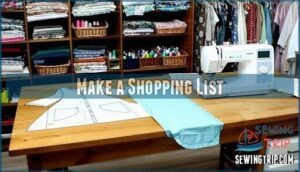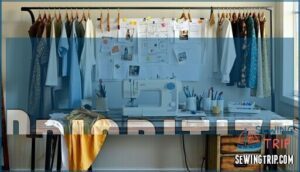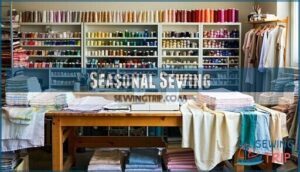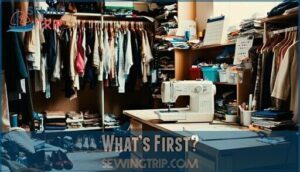This site is supported by our readers. We may earn a commission, at no cost to you, if you purchase through links.

First, assess what you actually wear versus what’s hanging in your closet collecting dust. Create a realistic shopping list of versatile pieces that’ll work overtime—think mix-and-match champions, not one-hit wonders.
Prioritize garments that shift between seasons and occasions, because who has time for single-purpose clothes? Map out your daily routine to spot wardrobe gaps, then play stylist with potential combinations.
Start with basics before tackling trendy pieces. The secret lies in understanding which foundational garments will open up endless styling possibilities, making them timeless investments for your wardrobe.
Table Of Contents
Key Takeaways
- Audit your current wardrobe first – Turn all hangers one direction, then flip them after wearing each piece to identify what you actually use versus what’s collecting dust in your closet.
- Focus on versatile basics over trendy pieces – Choose foundational garments that mix and match easily, creating multiple outfit combinations rather than single-purpose clothes that limit your styling options.
- Plan with your body model and lifestyle in mind – Use your measurements and daily routine to test outfit combinations before cutting fabric, ensuring each piece you sew will work with at least three others in your collection.
- Start seasonal planning one month ahead – Map fabric choices and patterns to your climate needs, prioritizing weather-appropriate selections that transition between seasons for maximum wearability.
I Decided to Sew a Me-Made Capsule Wardrobe
After years of following every sewing trend and buying patterns on impulse, I hit a wall with my handmade wardrobe.
Stop chasing every new pattern release – your closet will thank you later.
Random makes cluttered my closet while I still had nothing to wear.
That’s when I discovered the power of sewing wardrobe planning through a structured capsule wardrobe approach.
Instead of chasing the latest pattern releases, I committed to sustainable sewing with intentional fabric choices.
This shift transformed my entire style evolution from chaotic to cohesive.
Planning ahead solved my biggest sewing challenges while creating true wardrobe cohesion.
To begin, you’ll need to gather basic supplies for your projects.
Now I sew my own clothes with purpose, following a realistic project timeline that actually works.
This capsule wardrobe sewing method revolutionized how I approach handmade fashion.
How I’m Using My Body Model to Help Me Plan
Using your body model transforms wardrobe planning from guesswork into precision. This powerful tool brings Body Model Benefits that make all the difference in creating pieces you’ll actually wear.
Your body model becomes your virtual fitting room for Design Visualization before you cut a single piece of fabric. Here’s how to maximize this Personalized Sewing approach:
- Sketch different outfit combinations on your body model to see how pieces coordinate
- Test various color palettes and patterns against your figure for maximum harmony
- Evaluate which silhouettes flatter your unique shape through Silhouette Analysis
- Experiment with fabric draping and texture combinations for realistic Virtual Try-On effects
- Use body measurements to guarantee Accurate Garment Fit from the planning stage
This sewing wardrobe planning method prevents costly mistakes and guarantees every piece you create works together seamlessly. Your body model guides smart decisions about proportions, styling, and fit. For a smoother finish, consider using plaster of Paris to refine the mold.
Find The Holes
Three key steps will help you uncover wardrobe gaps that matter most.
First, try on everything seasonally appropriate and note which pieces you reach for repeatedly.
What makes these favorites work so well—is it the fabric, fit, or style?
Next, pay attention to your feelings when getting dressed.
Take note of items that excite you versus those that feel "meh."
This emotional wardrobe audit reveals more than you’d expect about outfit shortfalls.
Regularly check your sewing machine for potential needle problems that might damage fabric.
Make a Shopping List
Smart sewing project planning begins with creating a thorough shopping list that transforms your wardrobe vision into reality.
You’ll need to calculate fabric requirements for each planned garment, checking pattern availability at your favorite stores before committing to designs. Budget allocation becomes vital as you balance quality fabrics with realistic spending limits.
Start by organizing your needs into three essential categories:
- Fabric selection – Calculate yardage for tops, bottoms, and dresses based on pattern requirements
- Sewing patterns – Research reviews and check sizing charts for accuracy and ease of construction
- Trim selection and tool upgrades – List buttons, zippers, interfacing, and any equipment improvements needed
This methodical approach to sewing budget planning prevents costly mistakes and warrants your wardrobe essentials sewing project stays on track without breaking the bank.
Don’t forget to include essential cutting tools like fabric scissors to warrant precise cuts.
Play Matchmaker
Think of this step as playing cupid for your closet. Now that you’ve selected sewing patterns and fabric, it’s time to test outfit combinations before you cut a single thread.
Lay out fabric swatches next to pattern photos and experiment with different pairings. Does that floral print clash with your striped top pattern? Will your chosen denim work with both the blazer and cardigan you’re planning?
Create a visual mood board using photos, swatches, and sketches. Test color palettes by grouping fabrics together under different lighting. Pay attention to texture pairings – mixing smooth cottons with textured linens adds visual interest.
Focus on garment synergy, ensuring each piece works with at least three others in your planned collection. To guarantee a cohesive collection, consider how your pattern choices align with your personal style.
This matchmaking process reveals gaps in your wardrobe planning and prevents sewing isolated pieces that’ll gather dust. Smart capsule wardrobe planning means every garment earns its place through versatile style compatibility.
Prioritize
Priority becomes your compass when traversing the overwhelming world of sewing plans. Start with a thorough needs assessment of your current wardrobe gaps, then move into goal setting that aligns with your lifestyle needs.
Consider how often you’ll actually wear each planned garment—there’s no point crafting a formal blazer if you work from home in pajamas.
Smart time allocation means tackling your priority needs first:
- Essential basics that you’ll wear weekly deserve top billing
- Versatile pieces that mix and match with existing clothes maximize your investment
- Hard-to-find items that aren’t available in stores justify the sewing time.
When establishing realistic sewing goals, evaluate pattern choice and fabric selection based on complexity and your skill level. Understanding machine needle selection is vital for achieving quality results.
A beginner shouldn’t prioritize an intricate custom coat over simple knit tops. Your sewing goals should reflect both your wardrobe needs and available time.
Seasonal Sewing
After you’ve organized your priorities, seasonal sewing becomes your roadmap to year-round style success.
Fabric seasonality drives smart choices – wool blends for winter, breathable cottons for summer.
Weather appropriate selections keep you comfortable while looking polished.
Start by mapping seasonal patterns against your climate.
Trend forecasting helps identify which styles will carry forward, but focus on wardrobe staples that transcend fleeting fashion.
Your seasonal shift strategy should begin one month before weather shifts.
Understanding fabric content factors is key to ensuring comfort and durability.
Choose sewing patterns that work across multiple seasons for maximum versatility and value.
| Season | Fabric Options | Color Palettes |
|---|---|---|
| Spring | Cotton voile, linen blends | Soft pastels, fresh greens |
| Summer | Lightweight cotton, rayon | Bright whites, ocean blues |
| Fall | Ponte knits, wool crepe | Rich burgundy, warm camel |
What’s First?
After mapping out your seasonal sewing plans, you’re ready to tackle the Initial Assessment phase. Start by conducting a thorough wardrobe planning session – pull everything from your closet and sort by category.
This Goal Setting exercise reveals what you actually wear versus what’s taking up space. Next comes Style Exploration through pattern selection. Browse your favorite pattern companies and bookmark designs that speak to you.
Create a Timeline Creation by estimating how long each garment takes to complete.
How to Start Making a Capsule Wardrobe: Research First!
Research lays the foundation for successful wardrobe planning. Start by conducting a thorough wardrobe audit of your current closet. Turn all your coat hangers to face the same direction, then flip them around each time you wear something. After a month, you’ll clearly see which pieces earn their keep and which collect dust.
This simple trick reveals your wardrobe heroes – those reliable pieces you can’t live without. Pay attention to gaps where you’re making do or constantly reaching for the same few items. Notice when certain occasions leave you scrambling for something appropriate to wear.
Sewing success also depends on understanding fabric types for each garment. This research phase prevents costly mistakes and guarantees your sewing patterns align with real-world needs, creating a truly functional capsule wardrobe through strategic mix and match planning.
- Style Inspiration: Screenshot outfits you love and analyze what makes them work
- Color Palette: Document which colors you gravitate toward naturally in your current rotation
- Silhouette Selection: Note which cuts and fits make you feel confident and comfortable
Frequently Asked Questions (FAQs)
How Many Garments Should Be in My Capsule Wardrobe?
Like Goldilocks finding the perfect porridge, your capsule wardrobe shouldn’t be too big or too small.
Start with 15-20 versatile pieces that mix and match effortlessly.
You’ll discover what’s "just right" for your lifestyle.
What Fabrics Are Best for Sewing a Capsule Wardrobe?
Choose versatile fabrics like cotton, linen, and wool that work across seasons.
Stick to neutral colors—navy, gray, black, and white—then add one complementary accent.
Quality fabrics guarantee longevity and professional appearance.
How Often Should I Rotate Pieces in and Out of My Capsule Wardrobe?
Think of your capsule wardrobe like a garden that needs seasonal revitalization.
You’ll want to rotate pieces every three to six months, swapping out items based on weather changes and preventing style fatigue from wearing identical combinations, which helps to avoid fatigue.
What Sewing Patterns Work Well for a Capsule Wardrobe?
Classic shirt patterns, versatile pants, simple tops, and layering pieces form capsule wardrobe foundations.
You’ll want patterns offering multiple views, adjustable fits, and timeless silhouettes that mix effortlessly together across seasons.
How Can I Store My Capsule Wardrobe Between Seasons?
Seasonal wardrobe storage unfolds like organizing a library—systematic and purposeful.
Vacuum-sealed bags protect fabrics from moisture and pests. Cedar blocks repel moths naturally.
Label containers clearly by season. Store in cool, dry spaces.
Rotate pieces every three to six months for freshness.
What is the 10 item wardrobe rule?
The 10-item wardrobe rule limits your closet to just 10 versatile pieces that mix and match effortlessly.
You’ll choose quality basics, neutrals, and one statement piece to create multiple outfits while simplifying daily decisions, following the 10-item wardrobe rule.
How to create a wardrobe plan?
Like mapping a treasure hunt, you’ll start by evaluating your lifestyle needs and personal style preferences.
Declutter existing pieces, identify wardrobe gaps, then select versatile patterns and fabrics that mix seamlessly together.
How to plan your sewing projects?
Start by evaluating your current wardrobe and identifying gaps.
Choose versatile patterns that mix and match easily.
Set realistic timelines based on your schedule. Select fabrics that complement each other for cohesive results.
How do I plan a work wardrobe?
Like tailors from the Victorian era, you’ll assess your daily tasks first.
Choose versatile basics—blazers, trousers, blouses—in neutral colors.
Consider your office culture, then select patterns that mix and match for maximum outfit combinations.
How many garments should be in my capsule wardrobe?
A well-planned capsule wardrobe typically contains 25-50 pieces total, including 15-25 core items for mixing and matching.
You’ll want 3-5 tops, 3-4 bottoms, 2-3 layers, plus shoes and accessories for versatility.
Conclusion
Picture yourself confidently pulling together outfit after outfit from your handmade collection, each piece working seamlessly with the others.
When you learn how to plan sewing wardrobe strategically, you’re investing time upfront that pays dividends every morning.
Your thoughtfully curated capsule eliminates decision fatigue while showcasing your unique style.
Remember, successful wardrobe planning isn’t about quantity—it’s about creating versatile pieces that love each other.
Start with one foundational garment and watch your confidence grow with every stitch.












